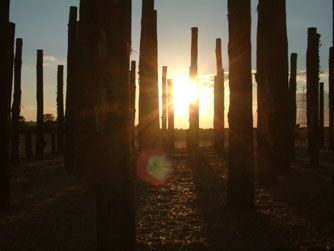Modelling the Sacred: The Clearing
 |
| Author's model |
 |
| Author's model |
'In the midst of beings as a whole an open place occurs. There is a clearing, a lighting… Only this clearing grants and guarantees to us humans a passage to those beings that we ourselves are not, and access to the being that we ourselves are.'
Heidegger (1935), 'On the Origin of the Work of Art'
The forest as metaphor is found throughout western literature, from the Grimm tales of Little Red Riding Hood and Hansel and Gretel, to more contemporary Shyamalan film 'The Village' (2004). The forest is a hostile place of chaos where the clearing is the [apparently safe] place where the truth is found.
In Heidegger the clearing (Lichtung in his terminology) expresses unconcealment wherein truth is found; it is where we learn of ourselves what we are not and what we are; dasein.
The forest clearing as a revelatory and reflective space has itself a long history in the European religious mind. The sacred nature of trees in pre-Christian faiths, the Druidic henges built of timber (and later stone), forming a clearing for the ritual activity.
 |
| Timber henge at Durrington Walls - Wikimedia Commons |
Vi ricordo, o boschi ombrosi
In the Inferno by Dante Alighieri the forest represents sin, and it is delivered from the forest that Dante encounters Virgil who guides him through the circles of Hell.
'Midway upon the journey of our life
I found myself within a forest dark,
For the straightforward pathway had been lost.
Ohime! how hard a thing it is to say
What was this forest savage, rough, and stern,
Which in the very thought renews the fear.'
Dante, (c.1300), 'l'Inferno, Canto I'
Dante, (c.1300), 'l'Inferno, Canto I'
The forest becomes profane space; an arena of sedition and mis-alignment of passion. It is from this chaos, and through it, that one approaches the sacred. A space made all the more safe in its contradistinction from its surroundings. A relief in the tumult of life.

Comments
Post a Comment